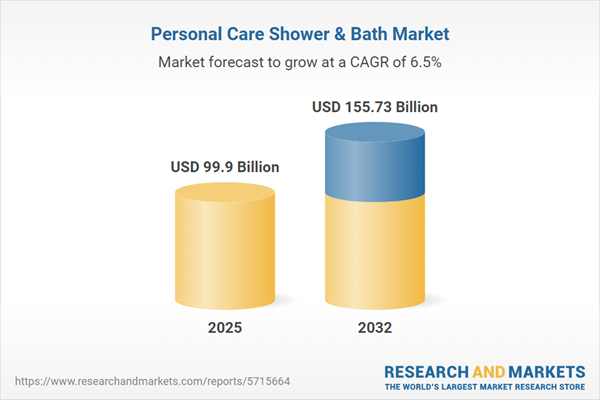Speak directly to the analyst to clarify any post sales queries you may have.
The Personal Care Shower & Bath Market is in a period of strategic transition, driven by evolving consumer expectations, regulatory shifts, and changing supply chain dynamics. Manufacturers, distributors, and brands must navigate rising demand for wellness, digital integration, and sustainability to maintain or build competitive advantage.
Market Snapshot: Personal Care Shower & Bath Market
In 2024, global revenues for the Personal Care Shower & Bath Market reached USD 93.75 billion, with growth expected to continue at a CAGR of 6.54%. By 2025, the market is forecast to achieve USD 99.90 billion, projecting an upward trajectory to USD 155.73 billion by 2032. This sustained expansion demonstrates resilient consumer demand, ongoing product innovation, and evolving competitive dynamics.
Scope & Segmentation
This market research delivers granular coverage across all major segments, capturing the full spectrum of product types, retail channels, and regional landscapes in the personal care shower and bath space.
- Product Types: Bath Additives, Bath Bombs, Bath Salts & Oils, Shower Gels, Soaps & Body Wash (including Bar Soap and Liquid Soap)
- Distribution Channels: Convenience Stores, Drug Stores/Pharmacies, Online Retail, Specialty Stores, Supermarkets/Hypermarkets
- Forms: Liquid, Solid
- End Users: Individual, Salon/Professional
- Price Ranges: Luxury, Mass, Premium
- Packaging Types: Bottle, Jar, Sachet, Tube
- Regions: Americas, Europe, Middle East & Africa, Asia-Pacific (including key sub-regions and major countries)
- Notable Companies: Unilever PLC, The Procter & Gamble Company, Johnson & Johnson, Colgate-Palmolive Company, Beiersdorf AG, Henkel AG & Co. KGaA, Reckitt Benckiser Group PLC, Kao Corporation, L'Oréal S.A., Shiseido Company, Limited
Key Takeaways for Senior Decision-Makers
- Wellness-focused offerings and consumer demand for sustainability, multi-functionality, and ethical sourcing are rapidly shaping product innovation and brand positioning.
- Omnichannel retail, powered by digital commerce and enhanced fulfillment, is driving brands to prioritize both online discoverability and in-store experience.
- Private label sophistication is rising, especially among retail partners investing in advanced product development, creating competitive pressure for established brands.
- Packaging, including recyclable and low-carbon materials, is no longer an option but a core differentiator in various distribution channels and price tiers.
- Supply chain resilience and regulatory compliance remain central to operational strategy, affecting sourcing, manufacturing footprints, and risk management.
- Regional characteristics influence product formats, pack sizing, and delivery models, necessitating a localized strategy for global success.
Tariff Impact & Trade Dynamics
Recent and anticipated tariff measures in the United States and other regions are compelling strategic adjustments in sourcing, supplier selection, and pricing initiatives in the shower and bath sector. Brands are exploring nearshoring, reformulation with local inputs, and altering packaging materials to minimize trade-related cost volatility. Distributors and retailers are adapting by renegotiating vendor terms and seeking new promotional mechanisms to address increased landed costs.
Primary Keyword: Personal Care Shower & Bath Market
The Personal Care Shower & Bath Market is characterized by complex matrixed segmentation, encompassing a variety of product types and packaging solutions designed to meet emerging demand patterns across key end-user groups. Digital and data-driven strategies are transforming go-to-market playbooks. Regional regulatory nuances further define the route to market for global and local brands alike.
Methodology & Data Sources
This report leverages a robust, multi-source approach including structured interviews with industry leaders, retail audits, product feed analysis, and scenario planning. Key insights are validated through expert panels and triangulation with publicly available market data, regulatory filings, and in-market audits.
Why This Report Matters
- Supports informed investment and operational decisions by delivering actionable segmentation, channel, and regional intelligence for the personal care shower and bath industry.
- Provides strategic guidance on risk management, supply chain optimization, and marketing adaptation to global and local shifts.
- Enables prioritization of product innovation, packaging, and channel strategy in the context of evolving regulations, tariffs, and consumer expectations.
Conclusion
Successfully capturing value in the personal care shower and bath category depends on synchronized product development, adaptable sourcing, and regionally attuned commercialization. Leadership belongs to those firms that balance global efficiency with local relevance and operational agility.
Additional Product Information:
- Purchase of this report includes 1 year online access with quarterly updates.
- This report can be updated on request. Please contact our Customer Experience team using the Ask a Question widget on our website.
Table of Contents
3. Executive Summary
4. Market Overview
7. Cumulative Impact of Artificial Intelligence 2025
Companies Mentioned
The companies profiled in this Personal Care Shower & Bath market report include:- Unilever PLC
- The Procter & Gamble Company
- Johnson & Johnson
- Colgate-Palmolive Company
- Beiersdorf AG
- Henkel AG & Co. KGaA
- Reckitt Benckiser Group PLC
- Kao Corporation
- L'Oréal S.A.
- Shiseido Company, Limited
Table Information
| Report Attribute | Details |
|---|---|
| No. of Pages | 196 |
| Published | October 2025 |
| Forecast Period | 2025 - 2032 |
| Estimated Market Value ( USD | $ 99.9 Billion |
| Forecasted Market Value ( USD | $ 155.73 Billion |
| Compound Annual Growth Rate | 6.5% |
| Regions Covered | Global |
| No. of Companies Mentioned | 11 |









